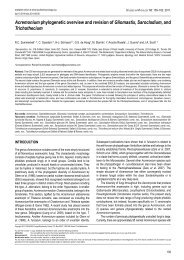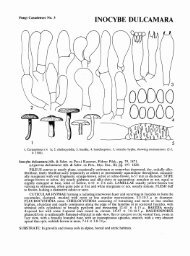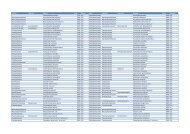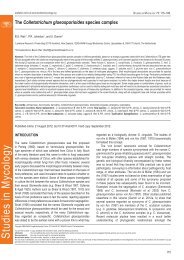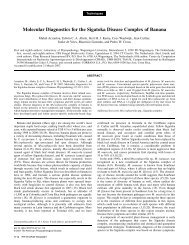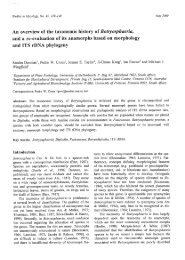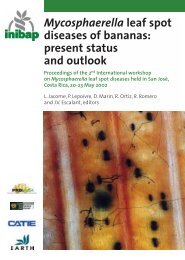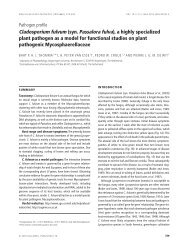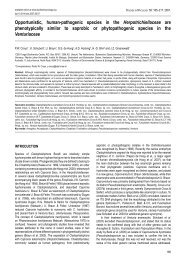Hypocrea rufa/Trichoderma viride: a reassessment, and ... - CBS
Hypocrea rufa/Trichoderma viride: a reassessment, and ... - CBS
Hypocrea rufa/Trichoderma viride: a reassessment, and ... - CBS
You also want an ePaper? Increase the reach of your titles
YUMPU automatically turns print PDFs into web optimized ePapers that Google loves.
DESCRIPTIONS OF THE SPECIES<br />
Continuous characters not provided in the descriptions<br />
are given in Table 2.<br />
1. <strong>Hypocrea</strong> <strong>rufa</strong> (Pers. : Fr.) Fr., Summa Veg. Sc<strong>and</strong>.,<br />
Sectio Post. 383. 1849. Figs 2–3, 7a–f, 8 a–e.<br />
≡ Sphaeria <strong>rufa</strong> Pers., Obs. Mycol. 1: 20 (1796) : Fr., Syst.<br />
Mycol. 2: 335. 1822.<br />
Anamorph: <strong>Trichoderma</strong> <strong>viride</strong> Pers., Neues Mag.<br />
Bot. [Roemer’s] 1: 92. 1794 : Fries, Syst. Mycol. 3:<br />
215. 1832.<br />
= <strong>Trichoderma</strong> lignorum (Tode) Harz, Bull. Soc. Imp. Natur.<br />
Moscou 44: 116. 1871.<br />
= <strong>Trichoderma</strong> glaucum E.V. Abbott, Iowa State Coll. J. Sci. 1:<br />
27. 1927.<br />
Stromata when fresh (Fig. 2d, h) 1–4(–6) mm long,<br />
0.5–1.5 mm high, solitary to gregarious, or aggregated<br />
in small numbers or crowded in lines along wood<br />
fibres, at first semi-effused, flat, velutinous, with white<br />
mycelial margin; becoming pulvinate, more rarely<br />
turbinate or discoid, circular to irregular in outline,<br />
surface smooth to slightly uneven to granular, broadly<br />
attached, margin often becoming free <strong>and</strong> concolorous<br />
with stroma surface; at first white, remaining white with<br />
yellowish ostiolar openings (“albino” form), or more<br />
commonly becoming variably coloured from the centre:<br />
first yellowish, then pale ochraceous, light brownish or<br />
yellow- to orange- to rust-brown (5A4–7, 5B4, 5C6–7,<br />
6CD5–8), later light to dark reddish brown (7–8CD6–8,<br />
8E7–8), sometimes with whitish to rust-coloured scurf;<br />
ostioles invisible or appearing as watery, hyaline, or<br />
indistinct darker dots, sometimes projecting, convex,<br />
often irregularly distributed.<br />
Stromata when dry (Fig. 2a–c, e–g) (0.5–)0.6–3<br />
(–5.7) mm long, (0.4–)0.6–2(–3.4) mm broad, (0.2–)<br />
0.3–0.6(–0.9) mm thick (n = 31), KOH – , darker <strong>and</strong><br />
surface more uneven than in fresh stromata, granular<br />
to finely tuberculate, sometimes extremely uneven with<br />
perithecial contours visible; ostioles not visible or partly<br />
convex or semiglobose, appearing as hyaline or brown<br />
dots, generally hyaline after addition of water (Fig. 2i);<br />
young stromata velvety to conspicuously hairy (Fig.<br />
2a, c), with diffuse yellowish orange, yellowish brown<br />
or (orange-)brown colours, 4B4–5, 5AB5–6, 5CD7–8,<br />
6B5, 6CD5–8, later light-, 7CD5–8, 7E7–8 to deep<br />
reddish brown, 8EF5–8 to 7F6–8, 8CD5–6, to dark<br />
brown, 7EF5–6; albino form white or becoming pale<br />
yellowish, 4A3–4, with numerous, conspicuous light<br />
brownish dots (Fig. 2f).<br />
Stroma anatomy: Cells of stroma surface in face view<br />
(Fig. 2m) pseudoparenchymatous, (3.5–)5–9(–14.5)<br />
µm (n = 30) diam, walls to 1 μm thick, reddish brown<br />
in water, orange-brown in lactic acid, pigment unevenly<br />
deposited in cell walls, giving a mottled appearance to<br />
the stroma surface. Ostiolar area in dry stromata (32–)<br />
40–84(–126) µm (n = 33) diam. Hairs (Fig. 2l) arising<br />
from the stroma surface, yellowish to pale brown,<br />
comprising 2–5 cells, apically rounded, rarely branched,<br />
sometimes consisting of only one inflated cell, (7.5–)10–<br />
HYPOCREA RUFA / TRICHODERMA VIRIDE<br />
29(–62) μm (n = 79) long, (2–)3.5–5(–6.5) μm wide (n =<br />
49), walls 0.5–1 µm thick. Cortical region (12–)17–30(–<br />
35) µm (n = 20) thick, cells forming a textura angularis,<br />
slightly compressed, reddish brown, in lactic acid<br />
orange-brown, (2–)3.5–9(–13.5) µm (n = 60) diam in<br />
vertical section, walls up to 1 µm thick. Cells immediately<br />
below the cortex comprising a mixture of intertwined<br />
hyphae, (2.5–)3–6(–6.5) µm (n = 10) wide, vertical <strong>and</strong><br />
parallel between perithecia, <strong>and</strong> few subglobose to<br />
angular cells similar to those of the cortex. Perithecia<br />
(Fig. 2k) (161–)182–245(–307) × (107–)140–210<br />
(–251) µm (n = 31), flask-shaped, ellipsoidal to globose.<br />
Ostiolar canal (70–)75–107(–120) µm (n = 21) long,<br />
(32–)33–55(–69) µm (n = 15) wide at the opening (Fig.<br />
2j), cells surrounding the ostiolar opening a palisade of<br />
hyaline, narrowly cylindrical, apically slightly exp<strong>and</strong>ed<br />
cells, plane with the surface or projecting to 14–43<br />
(–69) µm (n = 15). Peridium colourless, consisting of<br />
laterally strongly compressed thin hyphae, basally <strong>and</strong><br />
apically pseudoparenchymatous, indistinct, scarcely<br />
differentiated from <strong>and</strong> merging with the surrounding<br />
tissue, apical part flanking the ostioles conspicuously<br />
thickened. Tissue below the perithecia (Fig. 2n)<br />
of homogeneous, dense textura epidermoidea, of<br />
globose to elongate, thin-walled, hyaline cells, (4–)5–<br />
19(–26) × (3–)4.5–10(–12.5) µm (n = 30), not layered<br />
but cells gradually smaller <strong>and</strong> interspersed with few<br />
narrow hyphae towards the base of the stroma. Asci<br />
(Fig. 2q) cylindrical, (70–)87–112(–132) (n = 72) µm<br />
long, including a stipe of (5–)9–17(–22) µm (n = 30),<br />
(4–)5.5–7(–8.5) µm (n = 72) wide, stipe short, with a<br />
knob-like base, apical pore minute. Ascospores (Fig.<br />
2o, p) hyaline, verrucose, verrucae ca. 0.5 µm long<br />
<strong>and</strong> diam; dimorphic, distal part subglobose to oval,<br />
sometimes slightly tapered towards the upper end,<br />
proximal part oblong to wedge-shaped, the lower end<br />
broadly rounded.<br />
Colony characteristics: Optimal temperature for growth<br />
on PDA <strong>and</strong> SNA 25 °C, colony radius on PDA 30–35<br />
mm after 72 h in darkness, on SNA 22–31 mm; not<br />
growing at 35 °C. Colonies grown on PDA 1 wk at 25<br />
°C with alternating light (Fig. 7a–d) developing conidia<br />
in several alternating green (28DE5–7 to 27DE3–6<br />
to 27F7–8) <strong>and</strong> dull yellow (3A3–4) concentric rings.<br />
Diffusing pigment not noted. Slight coconut odour<br />
rarely noted.<br />
Colonies grown on CMD (Fig. 7e; 25 °C under<br />
alternating light) >7 cm, filling a Petri plate within 5–<br />
6 d, thin, hyaline, margin indistinct, diffuse, hyphae<br />
loosely arranged, no zonation, no pigment formed.<br />
Autolytic activity absent, coilings <strong>and</strong> aerial hyphae<br />
inconspicuous. A weak coconut-like odour formed<br />
in some but not all strains. Conidiation from 2 d, in<br />
pustules more or less regularly distributed on the<br />
plate or forming in a broad b<strong>and</strong> around the margin,<br />
less frequently in concentric rings, usually starting<br />
close to the point of inoculation, formed exclusively or<br />
preceded or accompanied by various amounts of simple<br />
conspicuously curved conidiophores or minute tufts.<br />
Pustules (Fig. 3a–b) at first white, becoming green from<br />
151




